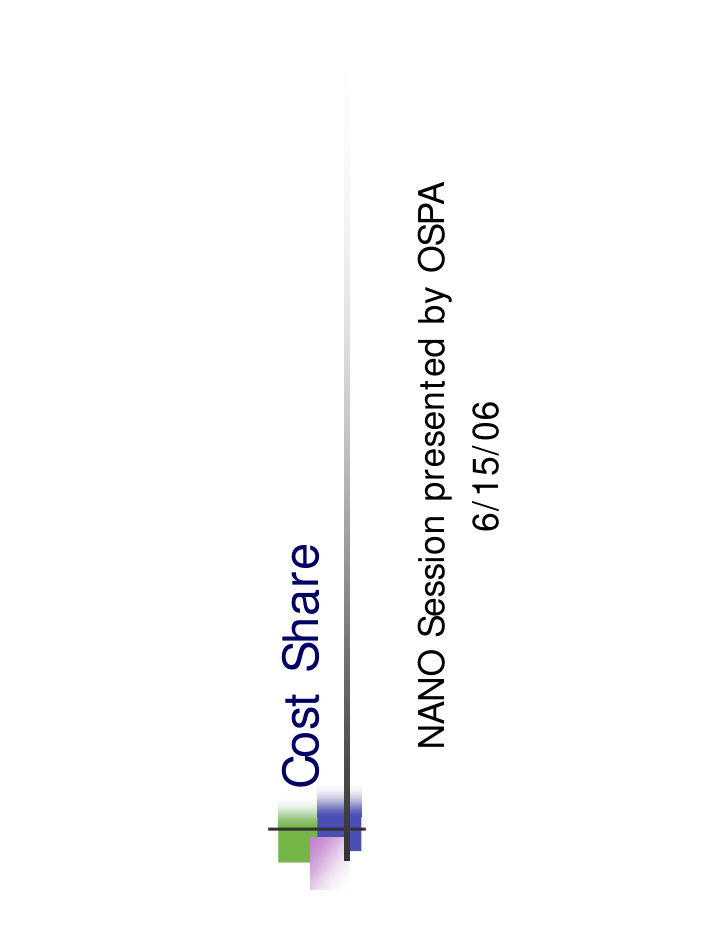



NANO Session presented by OSPA 6/15/06 Cost Share
What is Cost Share � Cost share is the portion of costs of a project or program that is not borne by the sponsoring agency � Can be provided by the University or a third party source � May be shown as cash or in-kind support � Can also be called matching
Types of Cost Share � Mandatory � Voluntary Committed � Salary Cap � Voluntary Uncommitted
Mandatory Cost Share Cost share that is required by a sponsor as a condition of making an award � This requirement will be specified in the program guidelines or Request for Proposal � Is usually expressed in terms of a percentage of the total project cost or a percentage of the funds being requested � Must be reported to the sponsor in the financial reports of the project
Voluntary Committed Cost Share Cost sharing that is not required by the sponsor, but is offered so as to be in a favorable position to receive the award � Is often included in response to sponsor guidance of “cost sharing is encouraged” or “cost share is a review criteria” � Becomes “mandatory” if offered in a proposal and accepted by the sponsor and is therefore subject to audit � The VPR strongly discourages PIs from including voluntary cost share in their proposals and budgets
Salary Cap Cost Share Occurs when the University proposes (or later assigns) effort by individuals whose salary exceeds a sponsor-imposed limit for individual salaries � Very rare, usually with NIH grants � Cannot be used to meet mandatory cost share requirements � Under OMB definition, is classified as voluntary committed cost sharing
Voluntary Uncommitted Cost Sharing Cost share that is not committed or budgeted for in a sponsored agreement � Most commonly is researchers’ effort which exceeds that which was committed and budgeted for � Additional support for a project that may have been listed in the proposal narrative, but not quantifiable terms � It does not need to be tracked or reported to the sponsor; it is not subject to audit
Voluntary Committed vs. Voluntary Uncommitted � Institutional “support” (uncommitted) can be provided without a cost share commitment � PI Jones will be available to consult on the project as needed (support) � Vs. PI Jones will devote 20% of his/her time to the project at no cost to the sponsor (commitment) � PI Smith will have access to the departmental data frabulator (support) � Vs. The deptartment will purchase a $15k data frabulator for PI Smith’s exclusive use in this project (commitment)
What Qualifies as Cost Share Costs must be: � Integral and necessary to the project � Allowable as direct costs or unrecovered F&A � Based on established rates, or FMV (fair market value) � Occur during the project period & are verifiable
What Does not Qualify as Cost Share � Contributions committed to another Federal Program or paid from another Federally funded project (unless authorized by the Federal Sponsor) � Any costs not allowed as a direct cost � Any funds from a third party without their consent
Why is Cost Share a Problem? � High Audit Risk � The September 2005 OIG Semiannual Report lists 7 reports with Cost share findings which includes the following: � Cost Share Promised - $20,739,099 � At Risk of Cost Share Shortfall (Ongoing project) - $993,921 � Actual Cost Sharing Shortfalls (Completed project) - $7,168,099 � Administrative burden caused by the extensive verification and monitoring � Lack of understanding can lead to unintended cost share commitments
Why is cost share a problem? � It effectively reduces our F&A rate
Why is Cost share a problem? (cont.) Consequences if cost share commitment is not meet: � Delay in reporting to sponsors � Unplanned commitment of resources by department/college � Potential award reduction, termination, suspension, disbarment
Documentation of Cost Share � The GoldSheet is considered sufficient documentation of cost share when: � The funds are from an ISU source that approved the GoldSheet � The cost share was documented on the GoldSheet properly � Please note that the SOURCE of cost share should be listed, not what is being cost shared � ie: Dept. of Chemistry or College of Engineering, not Salary and Benefits
Documentation of Cost Share (cont.) � ISU sources that do not approve the GoldSheet need to send an email or memo stating their approval � Third party sources should provide a signed letter stating their approval � All cost share documentation should be attached to the GoldSheet � Failure to secure proper documentation of cost share at the proposal stage may result in the source reneging and the PI is then left to cover the difference
Questions? � The ISU policy on cost share can be found at http://www.vpresearch.iastate.edu/docs/polic ies/cost_share_policy.pdf � For questions related to cost share on a proposal, you can contact OSPA at 294-5225 or ospa-proposals@iastate.edu � For post-award questions related to cost share, you can contact SPA at 294-4569 or !spa@mail.adp.iastate.edu
Recommend
More recommend